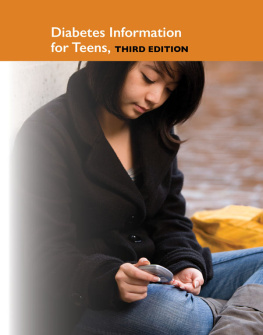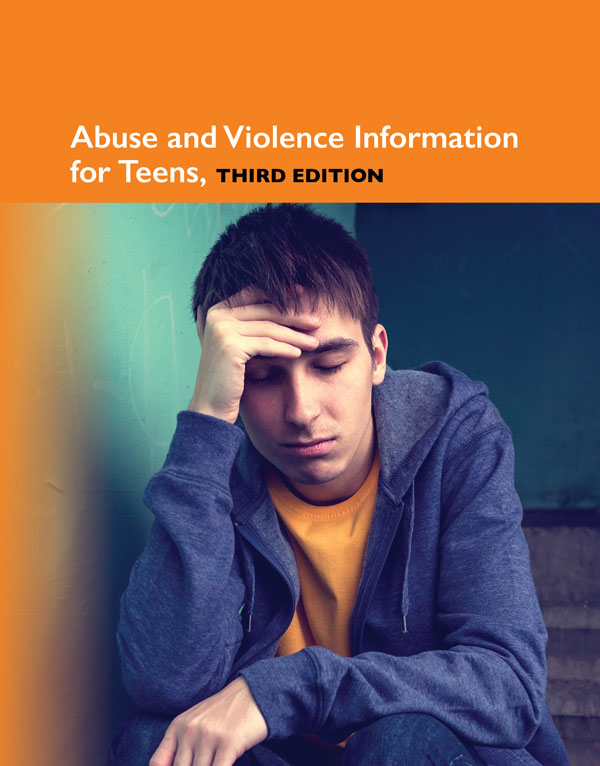Teen Health Series
Abuse and Violence Information for Teens, Third Edition
Teen Health Series
Abuse and Violence Information for Teens, Third Edition
Health Tips about the Causes and Consequences of Abusive and Violent Teen Behavior
Including Facts about the Types of Abuse and Violence, the Warning Signs of Abusive and Violent Behavior, Health Concerns of Victims, and Getting Medical Help and Staying Safe

615 Griswold St., Ste. 520
Detroit, MI 48226
Bibliographic Note
Because this page cannot legibly accommodate all the copyright notices, the Bibliographic Note portion of the Preface constitutes an extension of the copyright notice.
* * *
OMNIGRAPHICS
Angela L. Williams, Managing Editor
* * *
Copyright 2020 Omnigraphics
ISBN 978-0-7808-1743-2
E-ISBN 978-0-7808-1744-9
Library of Congress Cataloging-in-Publication Data
Names: Williams, Angela L., 1963- editor.
Title: Abuse and violence information for teens : health tips about the causes and consequences of abusive and violent behavior : including facts about the types of abuse and violence, the warning signs of abusive and violent behavior, health concerns of victims, and getting help and staying safe / Angela L. Williams, editor.
Description: Third edition. | Detroit, MI : Omnigraphics, Inc., 2019. | Series: Teen health series | Includes bibliographical references and index. | Audience: Ages 13 | Audience: Grades 7-9 | Summary: Provides basic consumer health information for teens about risk factors, consequences, and prevention of various types of abuse and violence. Includes index, resource information and recommendations for further reading.-- Provided by publisher.
Identifiers: LCCN 2019027356 (print) | LCCN 2019027357 (ebook) | ISBN 9780780817432 (library binding) | ISBN 9780780817449 (ebook)
Subjects: LCSH: Youth and violence--United States--Juvenile literature. | Youth and violence--United States--Prevention--Juvenile literature.
Classification: LCC HQ799.2.V56 A25 2019 (print) | LCC HQ799.2.V56 (ebook) | DDC 303.608350973--dc23
LC record available at https://lccn.loc.gov/2019027356
LC ebook record available at https://lccn.loc.gov/2019027357
Electronic or mechanical reproduction, including photography, recording, or any other information storage and retrieval system for the purpose of resale is strictly prohibited without permission in writing from the publisher.
The information in this publication was compiled from the sources cited and from other sources considered reliable. While every possible effort has been made to ensure reliability, the publisher will not assume liability for damages caused by inaccuracies in the data, and makes no warranty, express or implied, on the accuracy of the information contained herein.

This book is printed on acid-free paper meeting the ANSI Z39.48 Standard. The infinity symbol that appears above indicates that the paper in this book meets that standard.
Printed in the United States
Preface
About This Book
Teens experience violence in many forms, including bullying, fighting, hazing, dating violence, sexual abuse, domestic violence, and even homicide. According to a report from the Centers for Disease Control and Prevention (CDC), teen violence is a leading cause of death for young people and results in more than 475,000 nonfatal injuries each year. Nearly 1 in 5 high-school students are reported being bullied on school property in the year 2018. Each day, about 14 young people are victims of homicide, and about 1,300 are treated in emergency departments for nonfatal-assault-related injuries. The physical and emotional scars resulting from these experiences can endure a lifetime.
Abuse and Violence Information for Teens, Third Edition discusses contributing factors and warning signs for the most commonly experienced types of abuse and violence. Facts about seeking medical care and mental-health services for the physical and emotional consequences are included. A section on prevention and safety suggests ways to protect teens against violence and offers guidelines for staying out of harms way. In addition, information about the legal rights of a victim of sexual assault is provided, and the book features a statistical summary of abuse and violence, resource directories, and information on how and where to report child abuse.
How to Use This Book
This book is divided into parts and chapters. Parts focus on broad areas of interest; chapters are devoted to single topics within a part.
talks about the primary forms of abuse such as domestic violence, child abuse, and neglect. It discusses adverse childhood experiences and the impact of childhood trauma on well-being. It explains other forms of sexual abuse such as sibling and elder abuse, stalking, incest, and victimization of persons with disabilities. It also discusses the role new technologies play in child pornography and sexual exploitation.
activity, and hate crimes. The part concludes with facts about the effects of school violence exposure, teen firearm violence, self-injury, teen suicide, and violence against the lesbian, gay, bisexual, and transgender (LGBT) community.
outlines the impact of sexual abuse on the physical, mental, and psychological health of the victims. It explains what to do after a sexual assault, including seeking mental-health services, and discusses the long-term consequences of child abuse and neglect. It also discusses teen depression, posttraumatic stress disorder, trauma-focused interventions for youth psychotherapies, and therapeutic approaches for victims of sexual assault and abuse.
discusses how domestic violence and abuse can be prevented and treated. It also explains preventing violence at schools and promoting protective factors for children exposed to domestic violence. It talks about conflict resolution, suicide prevention, and how the child welfare system works. It concludes with information about the legal rights of a victim of sexual assault.
includes a statistical summary of abuse and violence, resource directories, and information on how and where to report child abuse.
Bibliographic Note
This volume contains documents and excerpts from publications issued by the following U.S. government agencies: Administration for Children and Families (ACF); Centers for Disease Control and Prevention (CDC); Child Welfare Information Gateway; CrimeSolutions.gov; Federal Bureau of Investigation (FBI); National Center for Posttraumatic Stress Disorder (NCPTSD); National Criminal Justice Reference Service (NCJRS); National Institute of Justice (NIJ); National Institute of Mental Health (NIMH); National Institute on Aging (NIA); National Institute on Drug Abuse (NIDA) for Teens; National Institutes of Health (NIH); National Oceanic and Atmospheric Administration (NOAA); Office of Adolescent Health (OAH); Office of Juvenile Justice and Delinquency Prevention (OJJDP); Office on Womens Health (OWH); U.S. Department of Education (ED); U.S. Department of Health and Human Services (HHS); U.S. Department of Justice (DOJ); U.S. Department of Veterans Affairs (VA); and Youth.gov.
It may also contain original material produced by Omnigraphics and reviewed by medical consultants.
The photograph on the front cover is Sabphoto/Shutterstock.











